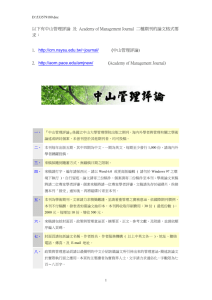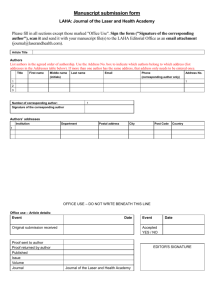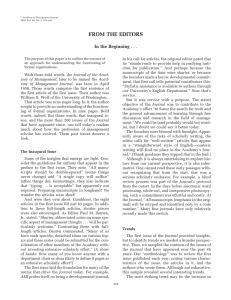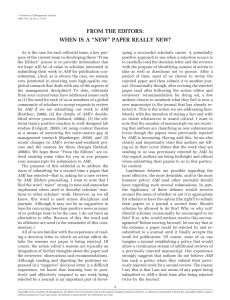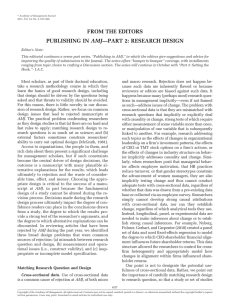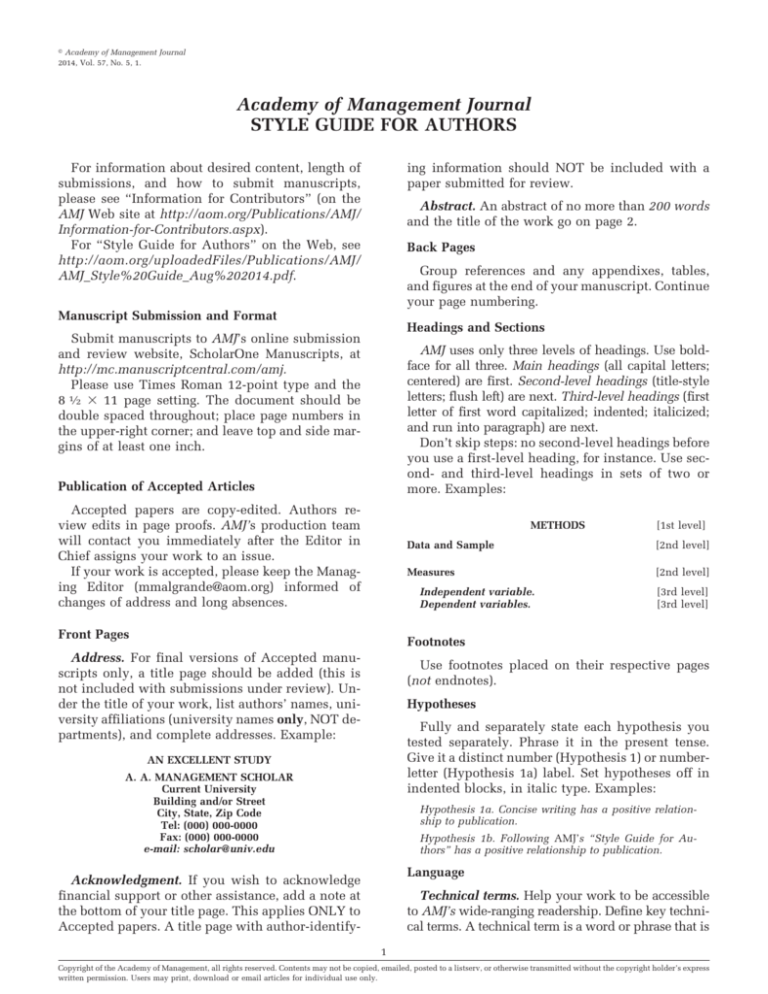
娀 Academy of Management Journal
2014, Vol. 57, No. 5, 1.
Academy of Management Journal
STYLE GUIDE FOR AUTHORS
For information about desired content, length of
submissions, and how to submit manuscripts,
please see “Information for Contributors” (on the
AMJ Web site at http://aom.org/Publications/AMJ/
Information-for-Contributors.aspx).
For “Style Guide for Authors” on the Web, see
http://aom.org/uploadedFiles/Publications/AMJ/
AMJ_Style%20Guide_Aug%202014.pdf.
ing information should NOT be included with a
paper submitted for review.
Abstract. An abstract of no more than 200 words
and the title of the work go on page 2.
Back Pages
Group references and any appendixes, tables,
and figures at the end of your manuscript. Continue
your page numbering.
Manuscript Submission and Format
Headings and Sections
Submit manuscripts to AMJ’s online submission
and review website, ScholarOne Manuscripts, at
http://mc.manuscriptcentral.com/amj.
Please use Times Roman 12-point type and the
8 1⁄2 ⫻ 11 page setting. The document should be
double spaced throughout; place page numbers in
the upper-right corner; and leave top and side margins of at least one inch.
AMJ uses only three levels of headings. Use boldface for all three. Main headings (all capital letters;
centered) are first. Second-level headings (title-style
letters; flush left) are next. Third-level headings (first
letter of first word capitalized; indented; italicized;
and run into paragraph) are next.
Don’t skip steps: no second-level headings before
you use a first-level heading, for instance. Use second- and third-level headings in sets of two or
more. Examples:
Publication of Accepted Articles
Accepted papers are copy-edited. Authors review edits in page proofs. AMJ’s production team
will contact you immediately after the Editor in
Chief assigns your work to an issue.
If your work is accepted, please keep the Managing Editor (mmalgrande@aom.org) informed of
changes of address and long absences.
METHODS
[2nd level]
Measures
[2nd level]
Independent variable.
Dependent variables.
Front Pages
[1st level]
Data and Sample
[3rd level]
[3rd level]
Footnotes
Address. For final versions of Accepted manuscripts only, a title page should be added (this is
not included with submissions under review). Under the title of your work, list authors’ names, university affiliations (university names only, NOT departments), and complete addresses. Example:
Use footnotes placed on their respective pages
(not endnotes).
Hypotheses
Fully and separately state each hypothesis you
tested separately. Phrase it in the present tense.
Give it a distinct number (Hypothesis 1) or numberletter (Hypothesis 1a) label. Set hypotheses off in
indented blocks, in italic type. Examples:
AN EXCELLENT STUDY
A. A. MANAGEMENT SCHOLAR
Current University
Building and/or Street
City, State, Zip Code
Tel: (000) 000-0000
Fax: (000) 000-0000
e-mail: scholar@univ.edu
Hypothesis 1a. Concise writing has a positive relationship to publication.
Hypothesis 1b. Following AMJ’s “Style Guide for Authors” has a positive relationship to publication.
Language
Acknowledgment. If you wish to acknowledge
financial support or other assistance, add a note at
the bottom of your title page. This applies ONLY to
Accepted papers. A title page with author-identify-
Technical terms. Help your work to be accessible
to AMJ’s wide-ranging readership. Define key technical terms. A technical term is a word or phrase that is
1
Copyright of the Academy of Management, all rights reserved. Contents may not be copied, emailed, posted to a listserv, or otherwise transmitted without the copyright holder’s express
written permission. Users may print, download or email articles for individual use only.
2
Academy of Management Journal
October
not in a general-use dictionary with the meaning you
(or even you and other published scholars) ascribe to
it. Put quotation marks around the first appearance in
your paper of each technical term, or define it.
Third person (less desirable)—The author developed
three new items.
Abbreviations. Avoid using abbreviations for the
names of concepts. Use ordinary words for variable
names—not code names or other abbreviations. Use
the same name for a variable throughout your text,
tables, figures, and appendixes.
Names of organizations and research instruments
may be abbreviated, but give the full name the first
time you mention one of these. Names of software
and some databases may be abbreviated.
Anthropomorphism. Do not describe inanimate
entities (models, theories, firms, and so forth) as
acting in ways only humans can act.
Reporting math. Do not “talk in math” in regular
text. Use words. For instance, “We surveyed 100 employees,” not “We surveyed n ⫽ 100 employees.”
Do use symbols and numbers to report results
and give formulas. Italicize letters that are customarily italicized (e.g., p, r, b, F, Z). Use boldface italic
for vectors. Put spaces on either side of equals
signs, minus signs, etc.
Illustrative results within text go in parentheses.
Introduce them with complete sentences. Example:
One coefficient for the interaction was significant
(model 3:  ⫽ 0.06, p ⬍ .05; model 5:  ⫽ 1.06).
Present equations either in your running text or
displayed. Examples:
Run-in equation—We used Craig’s (1992: 20) distance
formula (d ⫽ xyz).
Displayed equation—
Pr(Yt ⫽ yt xt) ⫽
[e ⫺ ( xt) (X t )yt ]
,
Yt!
(1)
where Yt is. . . .
Define each new term in all equations.
Sexist or biased language. Avoid language that
might be interpreted as denigrating. Do not use
“he” or “she” exclusively. Using the plural—
changing “the manager . . . he” to “managers . . .
they”—is one solution; using “he or she” (“him or
her”) is another.
Active voice and first person. Write in the active
voice (“They did it”) instead of the passive voice
(“It was done”) to make it easy for readers to see
who did what. Use the first person (“I” or “we”) to
describe what you, or you and your coauthors, did.
Examples:
Passive (less desirable)—Two items were found to lack
factor validity by Earley (1989).
Active (more desirable)—Earley (1989) found that two
items lacked factor validity.
First person (more desirable)—I developed three new
items.
Appendixes
Present long but essential methodological details, such as the calculation of measures, in an
appendix or appendixes. Be concise.
Avoid exact reproductions of surveys.
Label appendixes “APPENDIX A,” “APPENDIX
B,” and so forth. A substantive title, such as “Items
in Scales,” should follow. Label tables within appendixes “Table A1,” “B1,” and so forth.
Tables and Figures
Look at tables and figures in published issues of AMJ
to see preferred formats. Write to the copy editor if you
have questions. Use as many pages as you need to create
tables and figures that match our formats.
The preferred format for regular tables is Microsoft Word; however, WordPerfect and Acrobat
PDF are also acceptable. Note that a straight Excel
file is not currently an acceptable format. Excel
files should be converted to a Word or PDF document before being uploaded. Tables that contain
artwork or graphics must be submitted as illustrations in an acceptable format.
Tables should be formatted as follows. Arrange
the data so that columns of like material read
down, not across. The headings should be sufficiently clear so that the meaning of the data is
understandable without reference to the text. Tables should have titles and sufficient experimental
detail in a legend immediately following the title to
be understandable without reference to the text.
Each column in a table must have a heading, and
abbreviations, when necessary, should be defined
in the legend or footnote.
Number tables and figures consecutively (one series for tables, one for figures). Place them at the
end of your manuscript, but indicate the position of
each in the text as follows:
-----------------------------------Insert Table 2 about here
------------------------------------
Each table or figure needs an introductory sentence
in your text.
2014
Style Guide for Authors
More on tables. Use the same name for each
variable that you use in your text. Don’t use code
names and abbreviations. Example:
Desirable variable name—Profitability
Undesirable variable name—PRFT
Each table should report one type of analysis
(which is identified in the title), and each vertical
column and horizontal row should contain only
one type of data.
Report only two decimal places for all statistics.
Place correlation coefficients in the lower-left corners of their tables.
Use superscript small letters for table footnotes.
Significance levels go in a stack under your regular table footnotes. Example:
†
p ⬍ .10
* p ⬍ .05
** p ⬍ .01
Or you may use a single lettered footnote:
a
All values greater than . . . are significant at. . . .
More on figures. Figures, unlike tables, contain
drawings (e.g., an arrow, boxes). Make sure your
figures print out clearly so that they can be
scanned.
Do not use color.
3
Page numbers in citations. Use this format:
Writing a book is “a long and arduous task” (Lee, 1998: 3).
Citation with no author. For an article with no
author, cite the periodical as author. Example:
Periodical as author—Analysts predicted an increase in
service jobs (Wall Street Journal, 1999).
For reports, handbooks, and the like, cite the “corporate author” that produced them. Example:
Organization as author—Analysts predict an increase in
service jobs in the U.S. Industrial Outlook (U.S. Department of Commerce, 1992).
Such sources can also be identified informally. No
corresponding reference will then be needed.
Example:
Informal citation—According to the 1999 U.S. Industrial
Outlook, published by the U.S. Department of Commerce, service jobs will increase.
Electronic sources. Use a regular citation (author,
year) if you can identify an author of one of the
types discussed above (human, periodical, or corporate). If not, give the web address that was your
source in parentheses. No corresponding reference
need be used in the latter case.
References
Citations
These are your in-text, in parentheses, identifications of other research. Every work that has a
citation needs to have a corresponding reference
(see “References,” below). Examples:
Name and year—Several studies (Adams, 1994; Bernstein, 1988, 1992; Celias, 2000a, 2000b) support this
conclusion.
Year only—But Van Dorn and Xavier (2001) presented
conflicting evidence.
Order. Order citations alphabetically. Designate
two or more works by one author (or by an identical
group of authors) published in the same year by
adding “a,” “b,” and so forth, after the year. See the
“name and year” example above.
Multiple authors. If a work has two authors, give
both names every time you cite it. For three through
six authors, give all names the first time, then use
“et al.” in citations. Examples:
First citation—(Foster, Whittington, Tucker, Horner,
Hubbard, & Grimm, 2000).
Subsequent citation—(Foster et al., 2000).
For seven or more authors, use “et al.” even for the
first citation. (But the corresponding reference
should give all the names.)
References are your entries in the alphabetical
list at the end of your article or research note. This
list should include only work you have cited.
Order. Alphabetize references by the last name
of a sole author, a first author, or an editor, or by the
name of a corporate author (for instance, U.S. Census Bureau) or periodical (such as the Wall Street
Journal) if there is no human author or editor. Order works by an identical author by year of publication, listing the earliest first. If the years of publication are also the same, differentiate entries by
adding small letters (“a,” “b,” etc.) after the years.
Repeat the author’s name for each entry.
Books. Follow this form: Last names, initials
(separated by a space). Year. Title (Boldface italic,
capitalize only the first letter of the first word and
of the first word after a long dash or colon.) City
where published: Name of publisher. (For small
U.S. and Canadian cities, follow the name of the
city with the postal abbreviation for the state or
province; for small cities in other countries, give
the full name of the country.) Examples:
Granovetter, M. S. 1965. Getting a job: A study of contracts
and careers. Chicago: University of Chicago Press.
Kahn, R. L., & Boulding, E. (Eds.). 1964. Power and conflict in
organizations. Glencoe, IL: Free Press.
4
Academy of Management Journal
Katz, D., & Kahn, R. L. 1978. The social psychology of organizations (2nd ed.). New York: Wiley.
National Center for Education Statistics. 1992. Digest of education statistics. Washington, DC: National Center for
Education Statistics.
Periodicals. Follow this form: Authors’ last
names, initials. Year. Title (regular type; same single-capital rule as for books). Name of Periodical
(boldface italic, title-style capitalization), volume
number (issue number, if needed—see below): page
numbers. Examples:
Shrivastava, P. 1995. The role of corporations in achieving
ecological sustainability. Academy of Management Review, 20: 936 –960.
Nonaka, I. 1991. The knowledge-creating company. Harvard
Business Review, 69(6): 96 –104.
Include an issue number only if every issue of the
referenced periodical begins with a page numbered
1. (Look at more than one issue to check.)
If an article has no author, the periodical is referenced. Examples:
BusinessWeek. 1998. The best B-schools. October 19: 86 –94.
Harvard Business Review. 2003. How are we doing? 81(4): 3.
Chapters in books, including annuals. Follow
this form: Authors’ last names, initials. Year. Title
of chapter (regular type, single-capital rule. In Editors’ initials and last names (Eds.), Title of book:
Page numbers. City (same rules as above): Publisher. Examples:
Levitt, B., & March, J. G. 1988. Organizational learning. In
W. R. Scott & J. F. Short (Eds.), Annual review of sociology, vol. 14: 319 –340. Palo Alto, CA: Annual Reviews.
Dutton, J., Bartunek, J., & Gersick, C. 1996. Growing a personal,
professional collaboration. In P. Frost & S. Taylor (Eds.),
Rhythms of academic life: 239–248. London: Sage.
October
Unpublished works. These include working papers, dissertations, and papers presented at meetings.
Examples:
Duncan, R. G. 1971. Multiple decision-making structures in
adapting to environmental uncertainty. Working paper
no. 54 –71, Northwestern University Graduate School of
Management, Evanston, IL.
Smith, M. H. 1980. A multidimensional approach to individual differences in empathy. Unpublished doctoral dissertation, University of Texas, Austin.
Wall, J. P. 1983. Work and nonwork correlates of the career
plateau. Paper presented at the annual meeting of the
Academy of Management, Dallas.
Electronic documents. Include the author’s name,
if known; the full title of the document; the full title of
the work it is part of; the ftp, http, or other address;
and the date the document was posted or accessed.
Biographical Sketches
Each author of an accepted article is asked to
submit a biographical sketch of about 50 words.
Your sketch should identify where you earned your
highest degree, your present affiliation and position, and your current research interests. The first
author should include an e-mail address, which is
optional for the other authors.
Thank You
Your attention to the conventions described in
this guide will be much appreciated, will increase
the likelihood your submission will be favorably
reviewed, and will make the work of everyone involved—you, the reviewers, the editors, and the
readers— easier. Please contact AMJ Managing Editor Michael Malgrande at mmalgrande@aom.org
with your queries on AMJ’s style.

